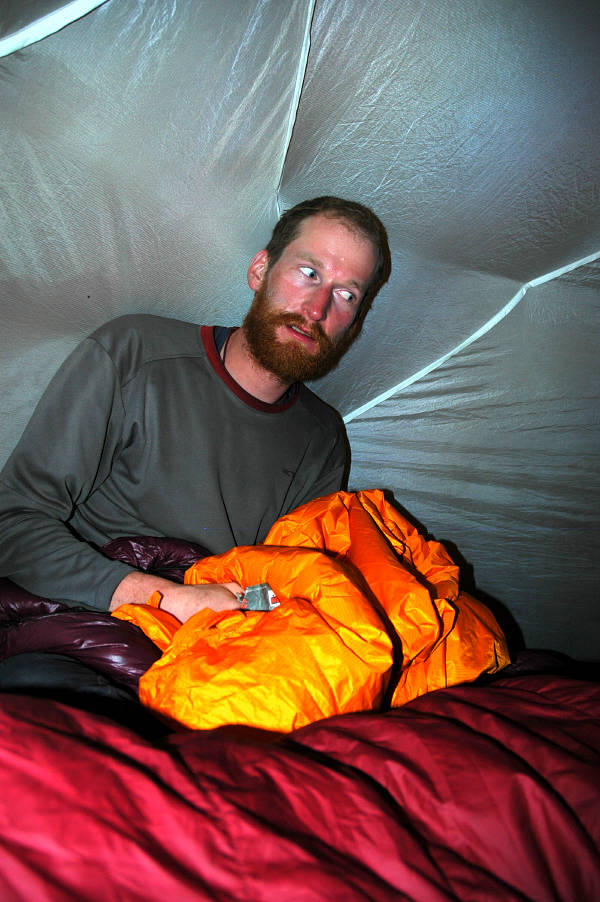A River of Ice
August 22, 2007
Rain fell on the tent, but I didn't care. I was warm and dry in my sleeping bag and we were not going anywhere until the rain stopped. Or until we annoyed each other so much that walking in the rain was preferable. Fortunately, the rain slackened around 11 am and we dropped our card game mid play to make a dash down the Scud. It was with no regret that we left the camp below Dokdaon and moved over to the food cache. Beginning the hike out brought a new flavor to the trip, one that I was looking forward to. The cache, however, was still full of food and our packs were the heaviest of the trip once we transfered all of the food inside it into our packs. Conditions on the Scud were favorable to making progress, even if the packs slowed our pace considerably.
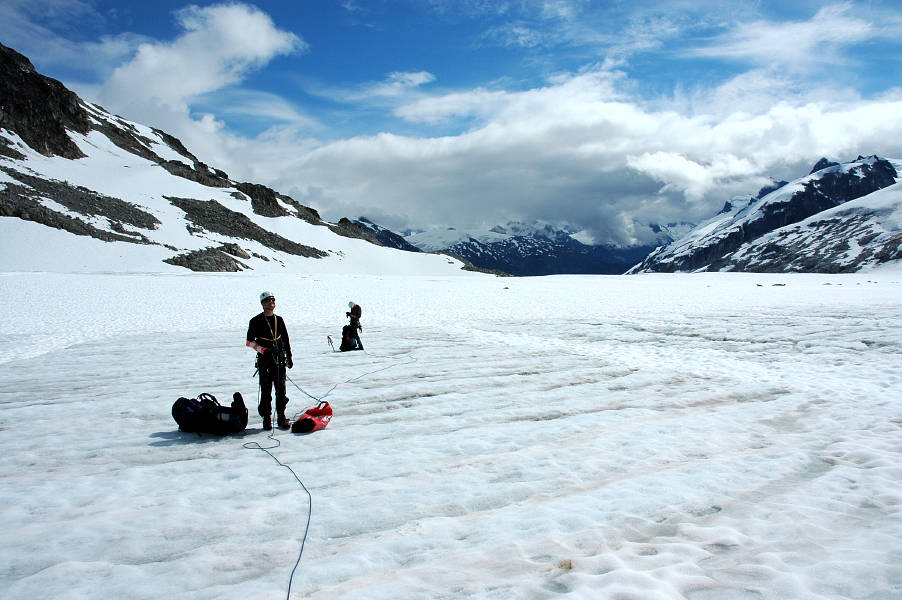
Traveling on a glacier that is well filled with snow is quite a joy: No crevasses means that you take a straight line, moving efficiently and rapidly. A glacier that is completely bare ice is almost as good: You end run crevasses, which are open and obvious. Though slightly slower, the footing is better and there are no worries about falling in. Things become tricky when the snow still covers the crevasses, but only thin enough to allow you the privilege of falling in. Then the stress level, at least for the person in front, ramps up and no one is particularly happy. Looking down the Scud, it was clear we'd have to make the transition somewhere, but that it would probably be a short one.

Travel on a glacier, like in the desert, can be deceiving. Distances appear much shorter than they actually are, and after an hour of walking down the glacier, all of our familiar landmarks seemed to be within reach of our hands: It didn't seem like we had gone anywhere despite my legs and back and shoulders telling me otherwise. The Doormouse looked like a short jaunt.
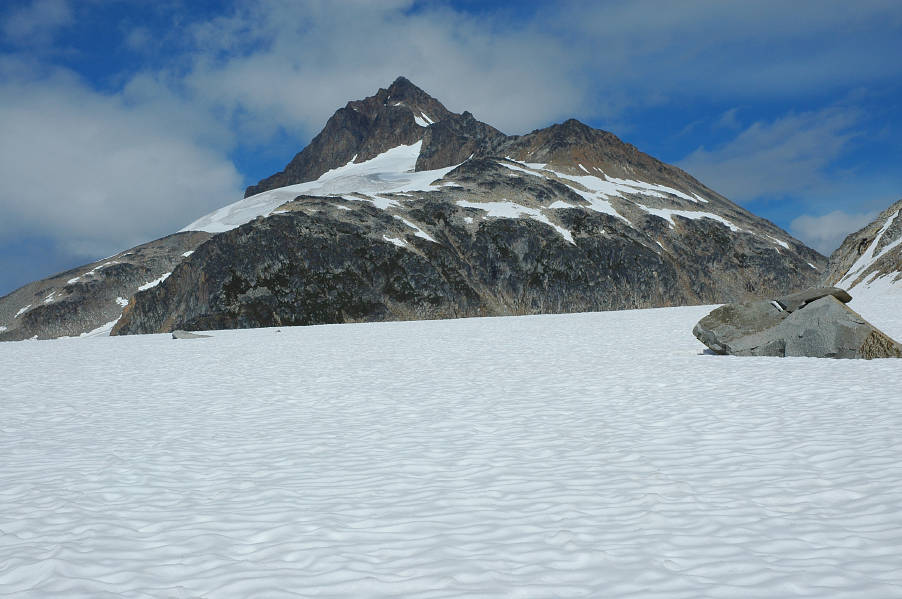
Dokdaon seemed even closer.

As we descended, the snow became thinner and patches of bare, blue ice more and more frequent. We began to treat snow we caution, and took to avoiding it altogether, fearing a fall that we could not arrest. Bob, being the lightest, was up in front while I, being the heaviest, was in the back. Mike, with his broken arm, was in the middle helping Bob route find through the snow patches, jumping from one stretch of bare ice to another.

We passed the edge of Dumper Ridge, along with the outflow of one of the many glaciers spilling off of White Rabbit. Though we had failed to summit along the west ridge (left skyline of the below photo), the route seemed even more impressive from this vantage and I was proud at having come so close to the summit, gone so far, surmounted so many obstacles.

Two hours from the food cache, the Scud was predominantly bare ice and we unroped for the rest of the walk. Normally I like to be on a rope when on a glacier, but here it just didn't make much sense. The crevasses were all open and in sight. If one of us fell in, the others would not be able to arrest on the ice and we'd all go in. And end-running the crevasses, while keeping the rope in an appropriate position, would take forever. Although I wasn't happy about being off a rope, Mike's argument couldn't be denied. After a few minutes, I relaxed enough and enjoyed the stroll.
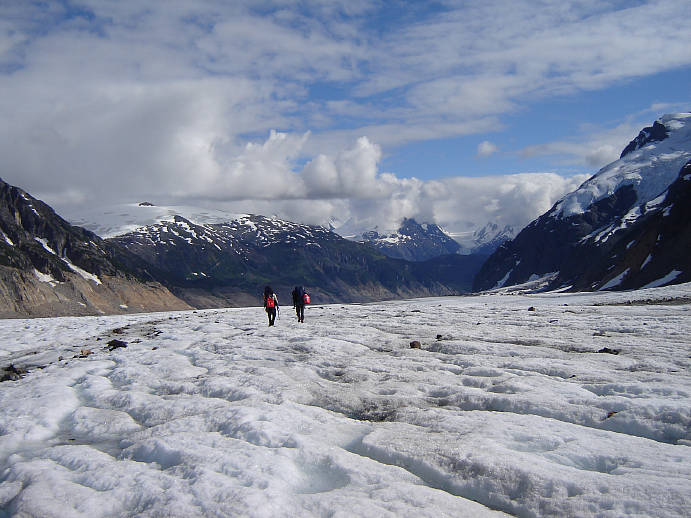
Hiking tends to allow the mind to relax and to promote thinking. This is unlike climbing, where you must maintain focus at all times, lest something rather bad happen. And we were now truly just in hiking mode, except that rather having a trail, we had a super highway river of ice to follow. The only care to be taken was not to fall into a crevasse or walk on anything except bare ice. But the packs, weighed down by food and climbing gear, were a persistent annoyance, one that kept the smooth thoughts of hiking from flooding my mind.
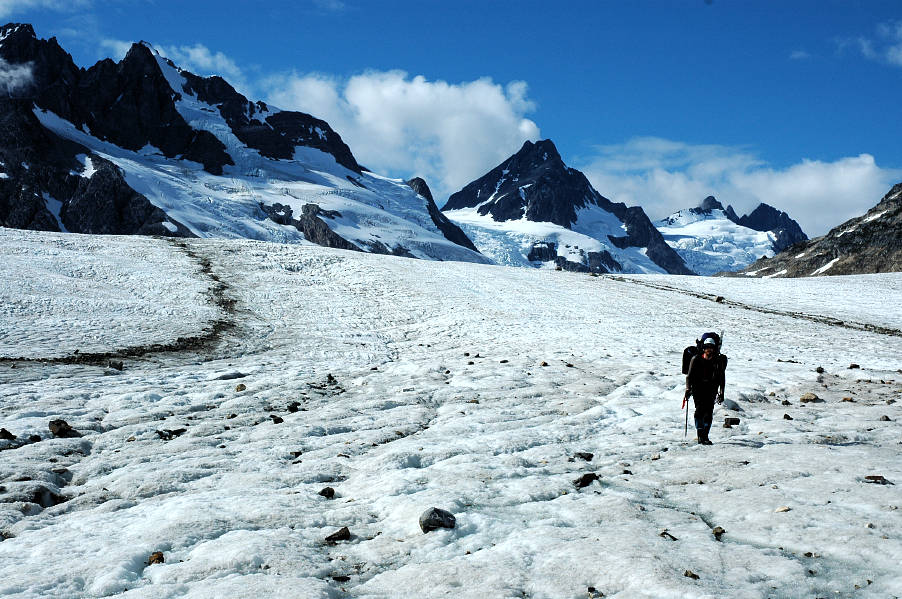
The Scud was a remarkably smooth, flat glacier, though it, like all glaciers, its shape was largely determined by the rock bed underneath it. As the glacier moved along, flowing like a river, it chewed up the rock underneath, spitting it out as sediment eventually. This sediment gives glacier streams a milky color and glacial lakes a preternatural green hue. If a glacier is wide enough, it can form into several distinct channels, or currents, which flow between moraines. A moraine is just a line of rock that is pushed up from below by the pressure of two channels. There are a variety of moraines, but the technical distinction, besides location, is lost on me.
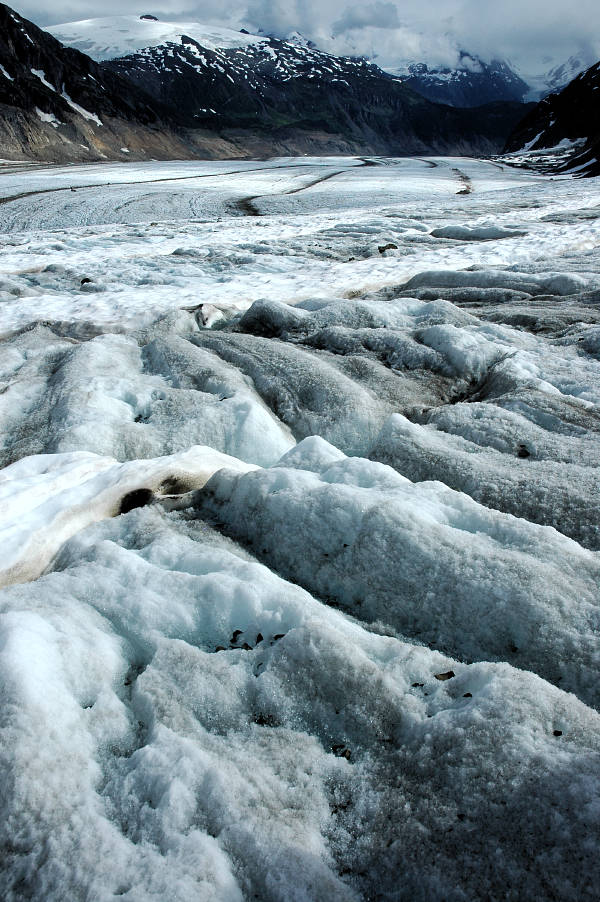
These moraines can also form when one glacier spills down into another glacier. Sometimes, however, rather than a moraine forming an ice fall will form. Keeping with the river analogy, an ice fall is like a waterfall, except formed by one river of ice coming down into a second one. In the below picture, you can see the ice fall formed by the Ambition glacier spilling into the Scud glacier.
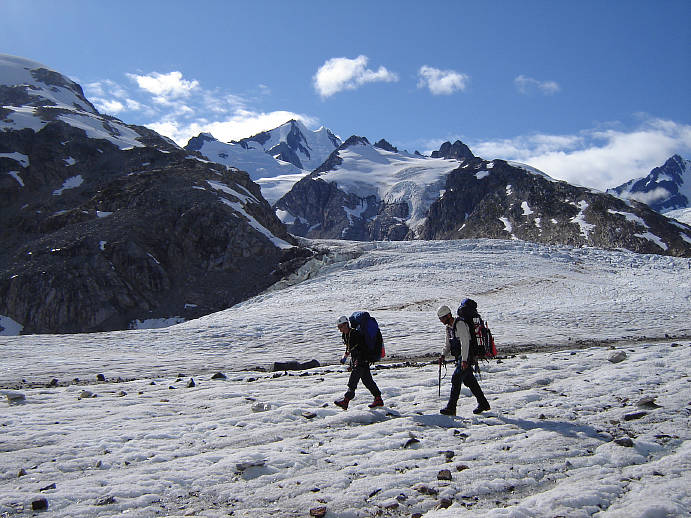
As glaciers rumble down, they fragment and fracture in places forming crevasses. The exact cause of a crevasse depends on many different things, such as temperature, the rock bed underneath, and snow fall the in years past. Some of these crevasses are deep, others shallow. Water flows along the glacier, sometimes on the surface, other times under the surface. Not all the water escapes out, however, and large pools, filling entire crevasses, frequently form. This water is pure glacial melt, without any rock sediment mixed in and is the best tasting stuff on the planet, though some may argue that an Appalachian spring has a more interesting taste to it.
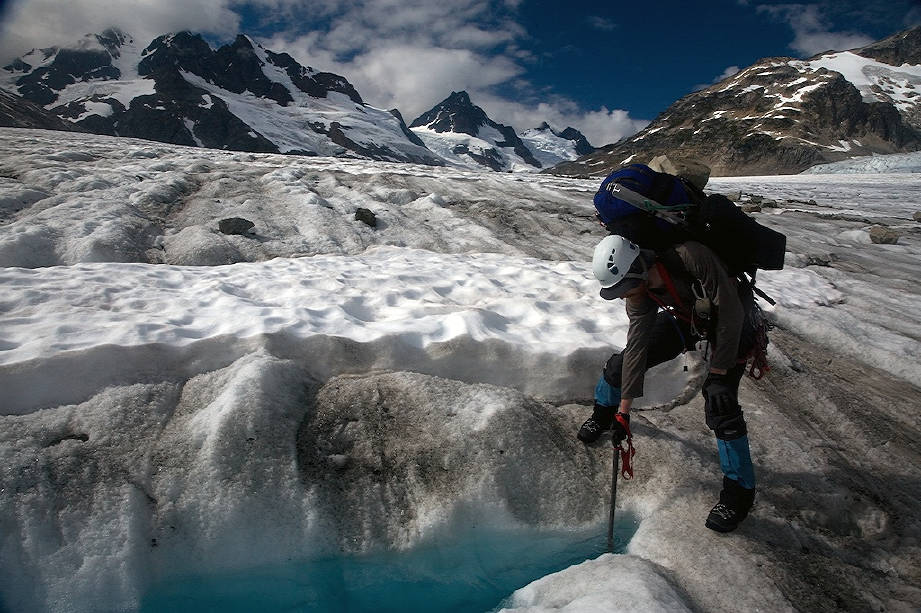
We took a long rest on a boulder in the middle of the Scud for lunch, and to ease the strain on our shoulders and backs. The rocks that were littering the Scud were not rockfall off the neighboring mountains: They were too far away. Rather the boulders, some the size of your fist, others the size of a VW Bus, were churned up from underneath, brought to the surface by the flow of the ice and the melting of the ice by the sun: The rocks were dark in color, and the sun warmed them more than the surrounding ice. This temperature difference caused enough melt that, over the years, the boulders were exposed.
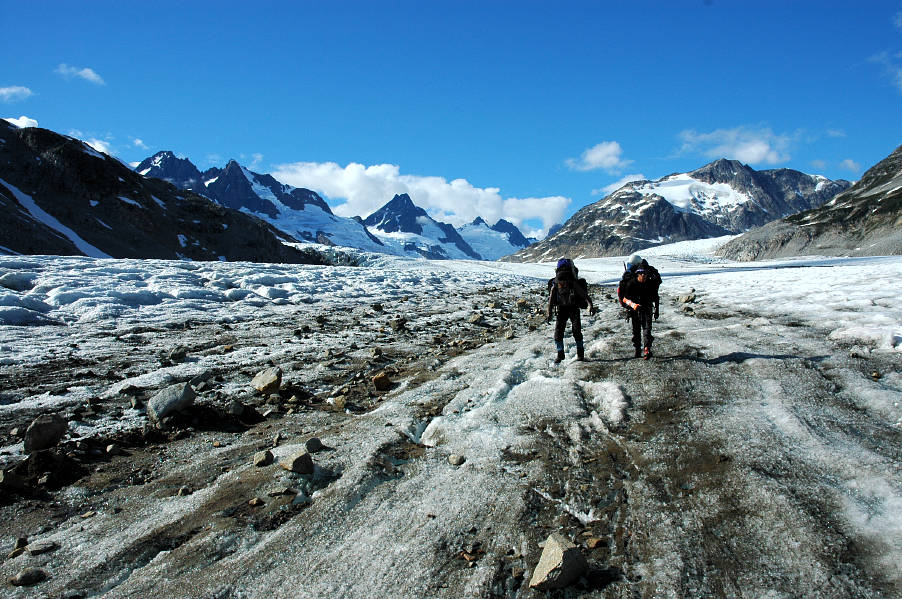
Our progress down the Scud had been more than expected and, as the sun was dipping below the western mountains, it was time to find camp. There were no thoughts of finding terra firma to camp on, for that was too far away. Instead, we found a flat patch of ice big enough for our tent, with water pools near by for drinking and cleaning, and called it home. On the east side of the glacier, further south than us, was a verdant valley where Mike, John, and Volker had stumbled upon during their 2004 traverse from Arctic Lake. I knew the story of that trip well and could imagine how much joy they felt after coming down from the snow above into the warm, pleasant valley. Indeed, I was looking forward to much the same thing tomorrow.
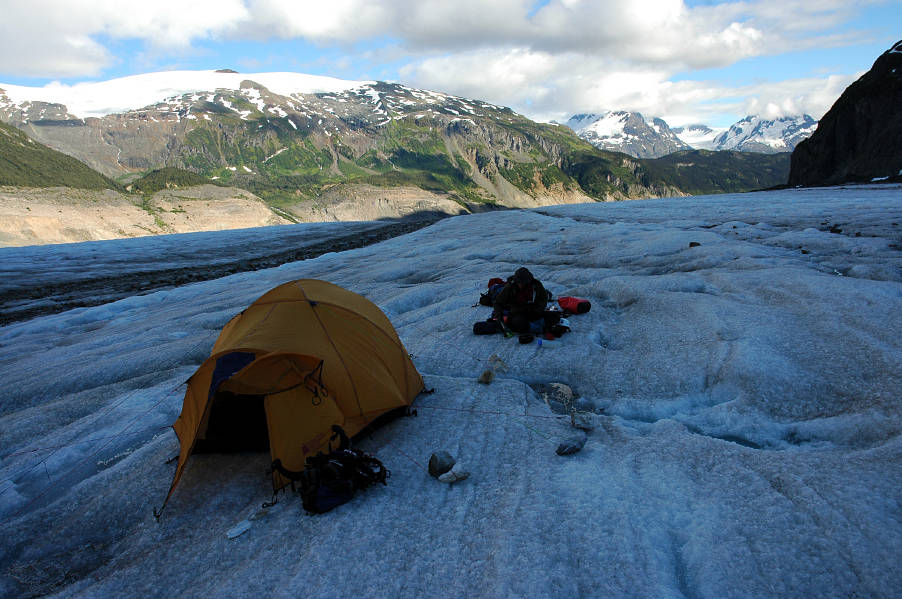
The temperature dropping rapidly, and the fact that we were directly on ice meant that we had a chilly evening. However, the surplus of food meant that we were able to have a double ration of hot soup, followed by a double dinner. We didn't especially need the calories, but it meant less weight on our backs for the ice fall below. The ice fall was our last objective hazard before reaching the Scud river and once past it we would only have a few days travel before reaching the Stikine and the end of our trip. It was barely 7 pm before we were all in the tent, in our bags, playing cards, and hoping for an easy route through the ice fall tomorrow.
I wanted, very badly, to get out of my bag and start down the Scud. I wanted to get down to the icefall, around it, and down into a green valley full of life. I wanted to revel in the smell of living things and sit next to a fire. I wanted all this, and I wanted it right now. However, my nose, the only thing sticking out of my sleeping bag, was too cold. Even though I wanted out, I wanted some warmth before I left my bag. It wasn't until 9:30 that we emerged from the tent and went about our morning routine. The sky was overcast and there was no sun to warm us, which kept our movements slow. It wasn't until 11:20 that we left our patch of ice for the remaining walk on the Scud.

There was more and more rubble on the glacier, indicating that we were nearing its end. The mountains around us, unnamed and unclimbed, didn't hold much attraction for me. Rather, I was focused on the life below the glacier. After two weeks of snow, rock, and ice, I was life-starved. I wanted to smell something other than myself, or Mike or Bob. A scent of something living. Something with some green in it, other than lichen.
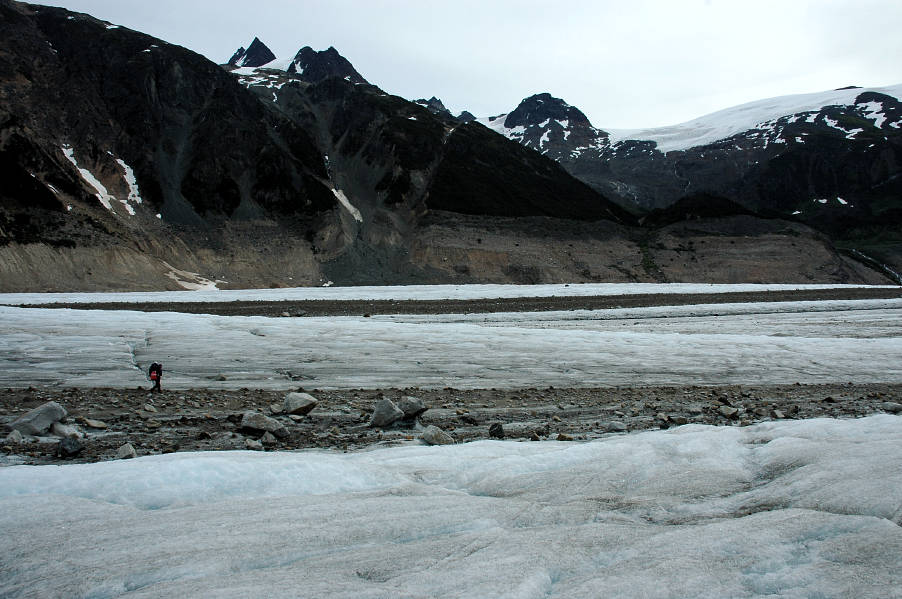
The walking continued to be easy and within 90 minutes we had reached a point were we could look down and see the valley below. But now a mystery presented itself to us. Mike had found a photograph of the icefall of the Scud in the current Department of Geography at the University of Victoria's calendar. The falls looked rugged and hard, but here we could see that there were no falls: The glacier simply ran down to the rubble below. The wide valley of the Scud River spread out below us, with the initial rocky area giving way to patches of green that would get only larger as we descended. The river looked large and braided, but it was also sitting, as far as we could see, in the middle of the valley.

After a good rest, we traversed over to the right side of the glacier and stepped off of the ice and onto the scree and talus filled slopes above. We side hilled along for about a kilometer, trying to stay on the right side of the outflow of the glacier. Although short, the traverse was rather unpleasant, with awkward footing and angles. We dropped off of it, and met with the first real life we had encountered in many days: A patch of lush grass.

We traversed through the grass and then dropped down along a ridge into a flat spot that once, perhaps a few weeks ago, held many wildflowers. But here, this far north, summer is short and the once lush area was now dying, or rather beginning to sleep. Still, the sight of so much green and red and pink and orange was a joy to our eyes, used to only brown, black, and white. The mystery of the ice fall was also solved. The photographer had taken a picture of the wrong ice fall, seen in the below photo. It is unclear how he could have made such a mistake.

Although is was only a little past 2 pm, we decided to make camp here and save any river fords for tomorrow. We were a full day ahead of schedule and everything looked positive for the road ahead. After getting the tent put up, Mike and Bob went out to explore a bit and rustle up some firewood, which I eventually joined them in doing. Thirty minutes of work netted us a large pile to burn, including some pieces that had clearly been cut with a saw, some with an axe, though very long ago. People, probably hunters, had clearly been up this way at some point, which meant that we could, hopefully, get down without too many difficulties. Of course, they may have come in by chopper or boat, neither of which we had at this exact moment.

The fire blazed, casting its warmth upon our faces and hands and feet. A fire in a wild place brings more to you than just warmth. It brings cheer as well and there were smiles through out the afternoon and evening. We had another double ration of soup, followed by a double dinner, in a fruitless attempt to lessen the weight on our backs, which had long been oppressive, and was threatening to become diabolical. But we didn't have very far to go to reach the Scud Portage and the Stikine. Indeed, on our maps it seems like we might be able to make it in three days, and thus have several rest days were could lay about, hopefully at some scenic spot with a nice creek running near by. The weather was looking more and more positive. We couldn't be stopped.
